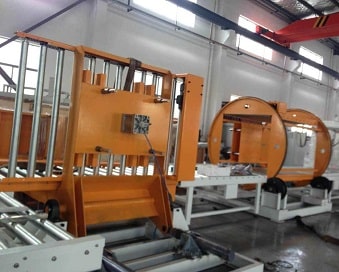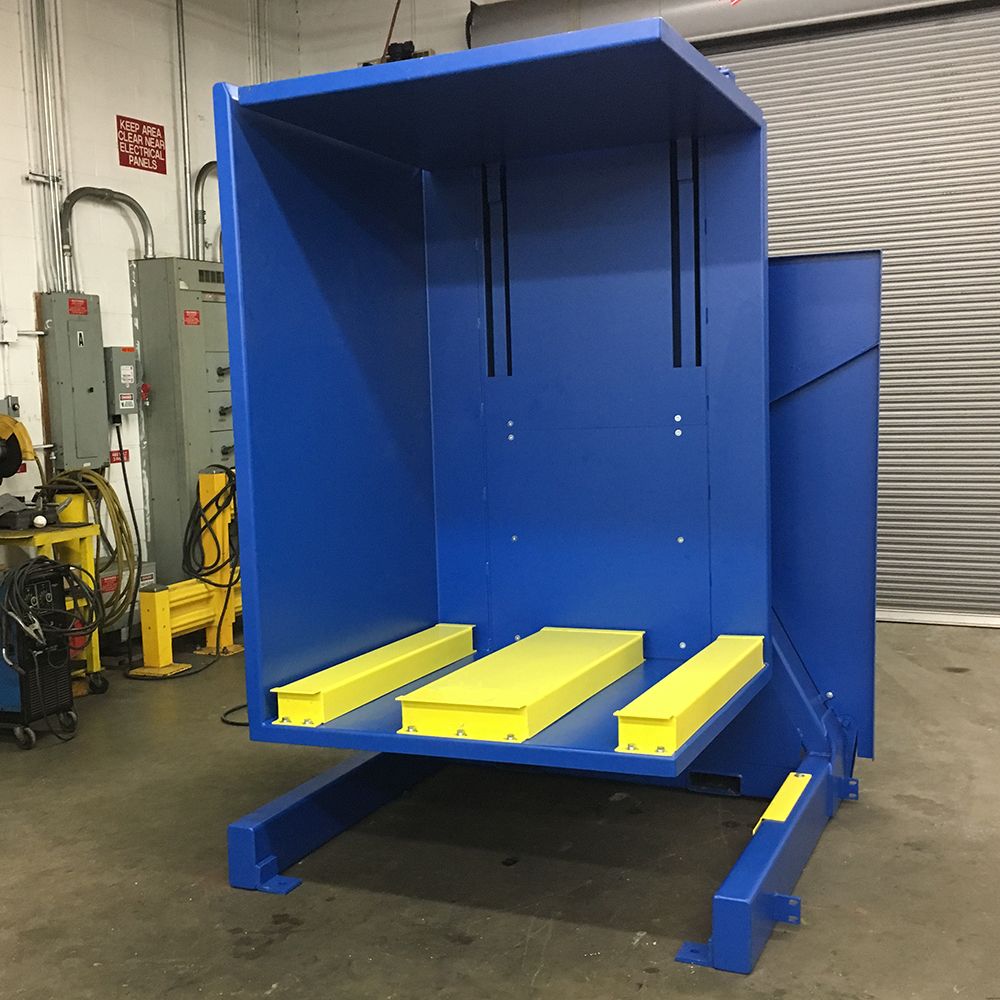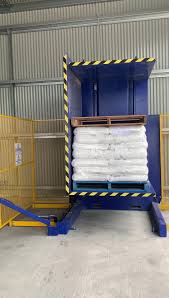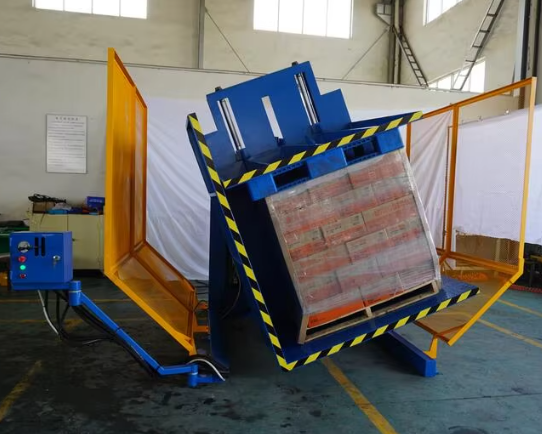Is Your Malaysia Factory Struggling with GMP Compliance and Labor-Saving Automation? Try a Pallet Changing Machine
Running a factory in Malaysia comes with unique challenges. You are constantly under pressure to meet international standards like Good Manufacturing Practices (GMP). At the same time, you face rising labor costs and a need for more efficiency. It can feel like you are being pulled in two different directions. You might worry that any investment in automation is too complex or expensive, leaving you stuck with manual processes that are slow, costly, and create compliance risks.
A pallet changing machine, also known as a pallet inverter, is a powerful solution to these problems. It automates the process of transferring goods from one pallet to another. This single piece of equipment can directly help your Malaysian factory achieve GMP compliance by improving hygiene and reducing contamination risks. It also delivers significant labor savings by turning a multi-person, manual task into a fast, one-person, automated operation.

I’ve spent my entire career in the packing machine industry, first as an engineer and later as a factory owner. I’ve seen firsthand how a single, smart investment can change everything. You are looking for ways to make your factory more competitive, more efficient, and more compliant. You are not just looking for a piece of metal; you are looking for a solution that solves real-world problems. A pallet changer is exactly that. It’s not just about speed; it’s about creating a safer, cleaner, and more profitable operation. Let’s explore how this machine can specifically help your business.
How can a pallet changer directly improve GMP compliance in your facility?
Are you finding it difficult to maintain strict hygiene standards in your production and warehouse areas? Manual handling of pallets can introduce contaminants, damage goods, and create major headaches during GMP audits. You might be using plastic pallets in your clean zones, but the process of manually transferring goods from incoming wooden pallets is slow, labor-intensive, and poses a constant risk of product contamination and worker injury.
A pallet changing machine improves GMP compliance by creating a clean break between external and internal logistics. It allows you to quickly and safely transfer goods from street-level wooden pallets to sanitized, in-house plastic or metal pallets. This process minimizes manual handling, reduces the risk of cross-contamination from wood, dust, and pests, and ensures product integrity, all of which are critical components of GMP standards.

A Deeper Look into GMP and Pallet Management
Good Manufacturing Practices are not just a set of rules to follow; they are a system for ensuring your products are consistently produced and controlled according to quality standards. In industries like food and beverage, pharmaceuticals, and electronics, controlling the environment is everything. Let's break down how a pallet changer becomes a key asset in your GMP strategy.
Contamination Control
The main goal of GMP is to prevent harm to the end consumer. A major source of contamination is often overlooked: the shipping pallet. Wooden pallets, while cheap and common, are a significant risk.
- Biological Contaminants: Wood is porous. It can absorb moisture, leading to mold and bacterial growth. It can also harbor insects and pests. When these pallets enter your clean production area, they bring these risks with them.
- Physical Contaminants: Old wooden pallets splinter. These splinters, along with nails and dust, can easily find their way into your products or processing area, creating a physical contamination hazard.
- Chemical Contaminants: Pallets may have been exposed to chemical spills during transport. These chemicals can leach into your products, especially if they are not properly sealed.
A pallet changer creates a physical barrier. You can designate an area where all incoming goods are processed through the machine. Wooden pallets never enter the clean zone. This simple change drastically reduces your contamination risk profile and makes passing GMP audits much easier.
Process Validation and Traceability
GMP requires that your processes are documented and repeatable. Manually transferring goods off a pallet is an inconsistent process. The method can change from worker to worker. It’s hard to document and even harder to validate. An automated pallet changer, however, performs the exact same way every single time. You can document the Standard Operating Procedure (SOP) easily. The cycle time is predictable. The handling is gentle and consistent. This level of control is exactly what auditors look for. It demonstrates that you have engineered a reliable process to protect your product.
Here’s a comparison of the manual process versus an automated one:
| Feature | Manual Pallet Transfer | Automated Pallet Changing |
|---|---|---|
| Consistency | Low; depends on the individual worker | High; machine follows a set program |
| Contamination Risk | High; direct handling, pallet enters clean zone | Low; pallet is exchanged at the boundary |
| Product Damage | Moderate to High; risk of dropping or crushing | Very Low; gentle clamping and rotation |
| Traceability | Difficult; hard to log each manual transfer | Easy; cycle can be logged in a MES system |
| SOP Compliance | Hard to enforce | Easy to enforce and audit |
Investing in a pallet changer is not just about buying a machine. It's about redesigning your workflow to build quality and safety in from the very beginning. It shows a commitment to GMP that goes beyond paperwork.
What are the real labor and cost savings from automating pallet exchange?
You look at your operational costs every day. Labor is always one of the biggest line items. You see teams of two or three workers spending valuable time manually re-stacking boxes from one pallet to another. This process is not just slow; it's expensive. You are paying for hours of work that add no real value to your product. You are also dealing with the hidden costs: worker fatigue, potential injuries from heavy lifting, and product damage from mishandling.
Automating with a pallet changer dramatically reduces direct labor costs by allowing one operator to do the work of several people in a fraction of the time. The savings extend beyond salaries. You also reduce costs associated with workplace injuries, product damage, and pallet rental or replacement programs. The machine pays for itself through improved efficiency and lower operational expenses.

Breaking Down the Return on Investment (ROI)
As a factory owner myself, I know that every investment must have a clear path to profitability. A pallet changer isn't just a "nice to have"; it's a financial tool. Let's analyze the tangible and intangible savings you can expect.
Direct Labor Cost Reduction
This is the most obvious saving. Let's do some simple math.
- Manual Process: Imagine it takes two workers 20 minutes to manually transfer a full pallet load.
- Automated Process: A pallet changer can do the same job in about 2 minutes with one operator.
Let’s put this into a table to see the impact over a year. We'll assume a moderate workload and labor cost.
| Metric | Manual Process | Automated Process |
|---|---|---|
| Workers per Task | 2 | 1 (supervisor) |
| Time per Pallet | 20 minutes | 2 minutes |
| Pallets per Hour | 3 | 30 |
| Labor Cost (Example) | 2 workers x 1 hour = 2 man-hours | 1 worker x 1 hour = 1 man-hour |
| Throughput Increase | - | 10x |
The numbers speak for themselves. You are not just saving one person's salary. You are re-deploying that labor to value-added tasks like quality control, machine operation, or packing. Your workforce becomes more productive. When I first implemented similar automation in my factory, I was amazed. My team was happier because the hard, boring work was gone. And my bottom line improved because their time was spent on more profitable activities.
Indirect Cost Savings
The financial benefits go much deeper than just labor.
- Reduced Product Damage: Manual handling leads to dropped boxes, crushed corners, and damaged goods. A pallet changer uses a gentle and controlled clamping system to secure the load before tilting or inverting. Damage rates can fall to near zero for this specific process. If you are dealing with high-value goods, this saving alone can be huge.
- Lower Workplace Injury Costs: Lifting heavy boxes all day is a primary cause of back and shoulder injuries. These injuries lead to medical costs, insurance premium increases, and lost productivity. Automating this task eliminates the physical strain, creating a safer workplace. This is not just good for your employees; it’s good for your business.
- Optimized Pallet Inventory: Many companies in Malaysia and around the world use pallet rental services like CHEP or Loscam. A pallet changer allows you to quickly transfer goods from these expensive rental pallets to your own cheaper, in-house pallets. This reduces rental fees and prevents your expensive pallets from being accidentally shipped out. You gain full control over your pallet pool.
Ultimately, the pallet changer transforms a cost center into an efficient, streamlined part of your operation. It’s a classic example of how automation delivers returns far beyond the initial purchase price.
How do you choose the right pallet changing machine for your specific needs?
You've seen the benefits, but now you face a new question: which machine is right for your factory? The market has many options, from simple pallet flippers to sophisticated in-line systems. Choosing the wrong one could mean wasted money and a machine that doesn't fit your workflow. You might be concerned about capacity, the type of products you handle, and how a new machine will integrate with your existing lines.
Choosing the right pallet changing machine requires you to analyze four key factors: your product and load type, required throughput (speed), your operational environment, and your level of automation. By matching the machine's capabilities—such as clamping pressure, rotation angle, and loading method—to your specific needs, you ensure a successful and efficient investment.

A Practical Guide to Selecting Your Machine
I've helped many clients navigate this decision. It’s a process of matching technology to a real-world problem. Think of me as your guide. Let's walk through the critical decision points together.
Step 1: Analyze Your Load
The first thing to consider is what you are moving.
- Load Stability: Are you handling robust, boxed goods, or fragile items like glass vials or open-top bags? For stable, boxed loads, a 180-degree inverter that turns the product upside down is fast and effective. For fragile or unstable loads, you need a pallet exchanger that pushes the load from one pallet to the other without tilting it, or a machine that only tilts to 95-120 degrees.
- Load Weight and Dimensions: Every machine has a maximum weight capacity and can handle certain pallet sizes. You need to know the heaviest and largest load you will ever need to process. Always choose a machine with a capacity slightly higher than your maximum requirement to ensure longevity and safety.
- Product Type: If you are in the food or pharmaceutical industry in Malaysia, you will need a machine with a stainless steel or "hygienic design" construction. These machines are built to be easily cleaned and to prevent the buildup of bacteria, helping you meet strict GMP standards.
Step 2: Determine Your Throughput Needs
How many pallets do you need to exchange per hour or per day?
- Low Throughput: If you only need to change a few pallets per day, a simple, stand-alone, forklift-loaded machine is perfect. It’s cost-effective and gets the job done.
- Medium to High Throughput: If you are processing 10 or more pallets per hour, you should consider a system with automated in-feed and out-feed conveyors. This allows the machine to run continuously while your forklift operator stages the next pallets, maximizing efficiency.
- Fully Automated Lines: For large-scale operations, the pallet changer can be integrated directly into your automated production or warehouse conveyor system, requiring no manual intervention at all.
This table can help you map your needs to a machine type:
| Throughput (Pallets/Hour) | Recommended Machine Type | Key Features |
|---|---|---|
| 1-5 | Stand-alone, Forklift-Loaded | Basic controls, lowest cost |
| 5-20 | Semi-Automated System | In-feed/out-feed conveyors, safety fencing |
| 20+ | Fully Integrated In-Line System | Connects to MES, full automation, no operator |
Step 3: Consider Your Space and Workflow
Where will the machine go? You need to consider the physical footprint of the machine and how it will fit into your factory's layout. Some machines require loading from one side and unloading from the other (flow-through design), while others can be loaded and unloaded from the same side. Think about the path your forklifts will take. The goal is to improve flow, not create a bottleneck.
Choosing the right machine is a partnership. A good supplier won't just sell you a box. They will work with you to understand your needs and recommend the best solution. That’s the philosophy I built my company on.
What is the implementation process and what challenges should you expect?
You are ready to move forward, but you feel a sense of hesitation. Bringing in a new, large piece of equipment can be disruptive. You are worried about the installation process, training your staff, and potential downtime. What if it doesn't work as expected? These are valid concerns for any practical factory owner.
A successful implementation of a pallet changing machine is a planned, multi-stage process involving site preparation, installation, commissioning, and training. The biggest challenges are typically ensuring proper site readiness (like floor strength and power supply), integrating the machine with your existing workflow, and getting your team comfortable with the new technology. A good supplier will guide you through every step to ensure a smooth transition.

From Purchase Order to Full Production: A Roadmap
From my experience helping dozens of factories automate, I can tell you that a successful project is all about planning. A pallet changer is not a simple plug-and-play device. Let’s break down the journey into clear, manageable steps.
Phase 1: Pre-Installation and Site Preparation
This phase begins the moment you place the order. It's the most critical phase for avoiding delays.
- Technical Drawings and Layout: Your supplier should provide detailed drawings of the machine. You will use these to plan the exact location. You need to check for overhead clearance, space for forklift access, and room for safety systems like light curtains or fencing.
- Foundation and Power: These machines are heavy and powerful. You must confirm that your concrete floor is thick enough to support the machine's weight and dynamic forces. You also need to run the correct electrical power and, in some cases, a compressed air line to the location. Getting this done before the machine arrives is essential.
- Workflow Planning: How will pallets get to and from the machine? You need to map out the new process flow. This might involve changing forklift routes or creating designated staging areas. Involving your warehouse supervisor and forklift operators in this planning is a great idea. They often have the best practical insights.
Phase 2: Installation and Commissioning
The machine arrives at your factory. Now the real work begins.
- Mechanical Installation: Technicians will position the machine, bolt it to the floor, and assemble any components like conveyors or safety fences.
- Electrical and Pneumatic Connection: Qualified electricians will connect the machine to your factory's power supply.
- Commissioning: This is where the magic happens. The technicians will power up the machine and test every function: clamping, tilting, conveying. They will run it with empty pallets and then with your actual products to fine-tune the settings, like clamping pressure and speed, to ensure it handles your loads perfectly and safely.
Phase 3: Training and Handover
A machine is only as good as the people who operate it.
- Operator Training: The technicians should train a core group of your operators. This training should cover daily operation, how to use the control panel, how to clear simple faults, and daily safety checks.
- Maintenance Training: Your maintenance staff needs to be trained on the machine’s mechanics, lubrication schedule, and basic troubleshooting. A good supplier provides comprehensive manuals and support.
- Handover: Once you are satisfied that the machine is running perfectly and your team is trained, the project is officially handed over.
Here is a typical timeline, though it can vary:
| Stage | Duration | Key Activities |
|---|---|---|
| Pre-Installation | 2-4 Weeks | Site prep, utility runs, workflow planning |
| Installation | 2-5 Days | Mechanical and electrical installation |
| Commissioning | 1-3 Days | Testing, fine-tuning, running test loads |
| Training | 1-2 Days | Operator and maintenance team training |
The key to overcoming challenges is communication and partnership. When you choose a supplier, you are choosing a partner for this entire journey. Choose one who has a clear plan and is committed to your success.
My Personal Take on Strategic Automation
I started my career on the factory floor. I know the smell of machine oil and the sound of a production line running smoothly. I also know the frustration of broken-down equipment and inefficient processes. When I eventually built my own factory, I didn't just want to make machines; I wanted to solve the problems I had faced myself.
Automation is not about replacing people. It's about empowering them. It's about taking the dull, dangerous, and dirty jobs and giving them to a machine. This frees up your people to use their minds for more valuable work—like improving quality, optimizing processes, and thinking about the next big step for your business.
A pallet changing machine is a perfect example of this philosophy. On the surface, it’s a piece of steel that moves boxes. But when you look deeper, it’s a strategic tool. It helps you meet global standards like GMP, making your products more competitive on the world stage. It lowers your operational costs, making your business more resilient against market fluctuations. It creates a safer workplace, showing your employees that you value their well-being.
This is the kind of investment that pays you back in more ways than one. It's not just an expense; it's a step towards building a stronger, smarter, and more sustainable factory for the future.
Conclusion
A pallet changer solves key challenges for Malaysian factories by boosting GMP compliance and delivering major labor-saving automation, turning a necessary process into a competitive advantage.

